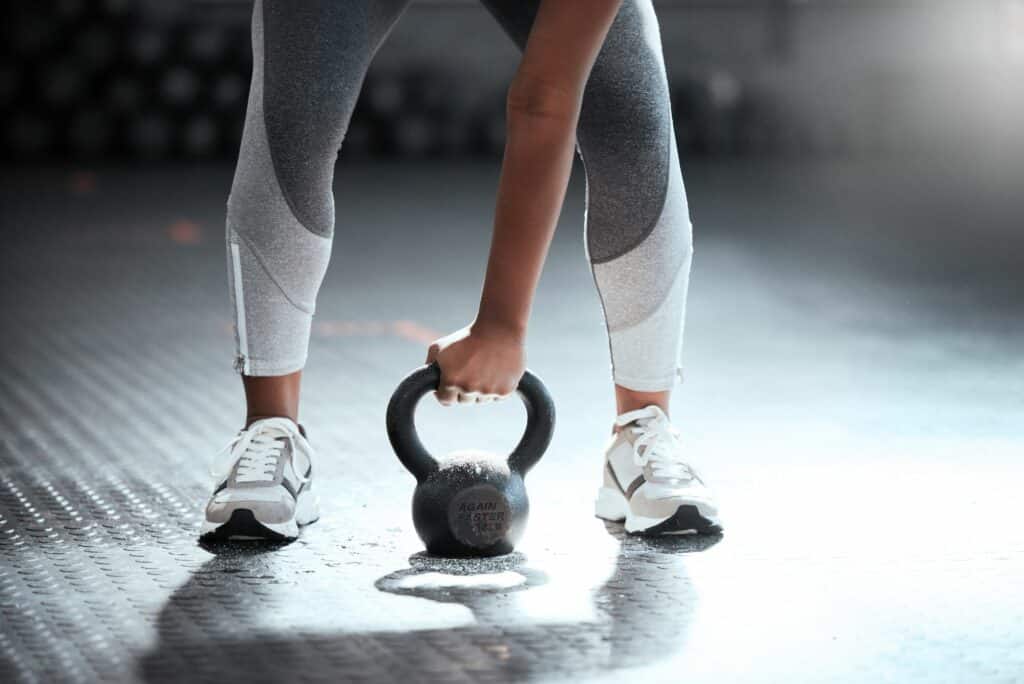


Aerobic vs anaerobic explained simply: Aerobic exercise involves oxygen and is great for endurance activities like running. Anaerobic exercise doesn’t use oxygen, focusing on high-intensity efforts like weightlifting. This article will detail how they work, their benefits, and practical examples.
The fundamental difference between aerobic and anaerobic exercise lies in how your body generates energy. Aerobic exercise relies on oxygen to produce energy, making it ideal for longer, lower-intensity activities like jogging or cycling. In contrast, anaerobic exercise generates energy without oxygen, relying on stored glycogen within the muscles for short, high-intensity bursts of activity such as sprinting or weightlifting.
Aerobic exercises enhance cardiovascular fitness and improve endurance through aerobic training by increasing the efficiency of oxygen utilisation. This allows your heart and lungs to supply more oxygen to your muscles for longer durations.
Anaerobic exercises focus on building muscle mass and strength through intense efforts that push your muscles to their limits, highlighting the anaerobic exercise training effects.
Integrating both aerobic and anaerobic training in your fitness routine can boost performance and speed up recovery, making workouts more effective and comprehensive.
Understanding these key concepts, whether aiming to improve endurance, build strength, or both, is the first step toward a balanced and successful fitness journey.

Aerobic exercise refers to physical activities that require oxygen to produce energy over extended periods. These exercises typically involve continuous, steady-state movements that can be sustained for longer durations. Examples of aerobic exercises include swimming, brisk walking, and cycling, all of which are characterised by rhythmic muscle movements and can be adjusted in intensity.
Aerobic exercise increases your heart rate and widens blood vessels, improving circulation and respiratory function. This promotes cardiovascular health and builds endurance, making it a cornerstone of any well-rounded fitness routine. It is recommended to engage in aerobic activities for at least 150 minutes each week, or about 30 minutes per day, to maintain optimal health and fitness.
Regular aerobic exercise offers benefits beyond cardiovascular health, including better respiratory function, increased oxygen efficiency, and enhanced endurance. Activities like jogging, cycling, or swimming are vital for maintaining a healthy and active lifestyle.

Anaerobic exercise involves short, intense bursts of activity using stored muscle energy without oxygen. It relies on muscle glycogen for quick energy, producing lactic acid as a by-product, and is ideal for high-intensity sports and explosive movements.
Weightlifting, sprinting, and high-intensity interval training (HIIT) are common anaerobic exercises essential for building muscle mass, increasing strength, and enhancing power. However, their intensity can lead to muscle fatigue and lactic acid buildup.
Incorporating anaerobic exercises into your fitness regimen improves muscle strength and endurance by pushing muscles to their limits. Activities like weightlifting, sprinting, or HIIT are crucial for a balanced fitness routine.
Understanding the energy systems your body uses during exercise is key to distinguishing between aerobic and anaerobic training. Adenosine triphosphate (ATP) is the primary energy source, continuously replenished during exercise. At rest and during lower-intensity activities, the body relies on the aerobic system using oxygen to replenish ATP.
Conversely, the anaerobic glycolysis system rapidly generates energy using muscle-stored glucose without requiring oxygen, producing lactic acid and leading to muscle fatigue during intense efforts. The predominant energy system depends on activity intensity and duration: lower-intensity, longer exercises use aerobic energy, while higher-intensity, shorter efforts rely on anaerobic energy systems.
Understanding these energy systems helps tailor workouts to maximize performance. High-intensity interval training (HIIT), for instance, uses both aerobic and anaerobic systems, offering a comprehensive workout that improves endurance and strength.
Incorporating a mix of aerobic and anaerobic exercises into your training regimen optimises fitness outcomes, ensuring a balanced and effective workout routine.
Regular aerobic exercise notably benefits cardiovascular health. Activities like jogging, swimming, or cycling enhance heart and lung efficiency, improving cardiovascular fitness and respiratory function. This increased efficiency supports sustained physical activity and overall endurance.
A major benefit of aerobic exercise is its potential to lower the risk of chronic conditions like heart disease and diabetes. The Copenhagen City Heart Study found that regular aerobic activity reduces mortality risk, highlighting its long-term health benefits. Aerobic exercises also help maintain healthy blood pressure, further supporting cardiovascular health.
Aerobic exercise promotes better blood circulation and lung function, benefiting overall health. Regular aerobic activities can improve mental health, reduce symptoms of depression and anxiety, and enhance cognitive function. Incorporating aerobic exercise into your routine offers extensive health benefits and helps maintain a high quality of life.

Anaerobic training complements aerobic exercise with unique benefits. Regular anaerobic workouts increase muscle mass and strength and enhance fat loss. High-intensity activities like weightlifting, sprinting, or plyometrics build and tone muscles quickly, contributing to a more robust and powerful physique.
Besides muscle development, anaerobic training improves bone mineral density, reducing the risk of osteoporosis. This is crucial as we age, helping to prevent fractures and injuries. The intense nature of anaerobic workouts also boosts metabolism, aiding in weight management and overall fitness.
Incorporating anaerobic exercises into your fitness routine enhances physical performance and overall health. Balancing anaerobic training with aerobic activities creates a comprehensive workout regimen addressing all aspects of fitness.
Combining aerobic and anaerobic workouts effectively achieves a balanced fitness routine. Integrating both types of exercise maximises benefits and creates a comprehensive workout schedule. Alternating between anaerobic and aerobic exercises on different days targets various muscle groups and energy systems, promoting overall fitness and performance.
Varying exercise intensity throughout the week is beneficial. High-intensity anaerobic sessions like sprinting or weightlifting can be complemented by lower-intensity aerobic activities like jogging or cycling. This approach prevents overtraining and reduces injury risk, ensuring ample recovery time and adaptation to workout demands.
Listening to your body is crucial when combining different workouts. Fatigue or soreness may indicate the need to adjust your routine, prioritize recovery, or consult a fitness professional. Proper recovery, including adequate sleep and nutrition, is essential for adapting to workout demands and preventing injuries.
Mixing aerobic and anaerobic training enhances overall performance and provides a more varied and engaging fitness routine.
Safety should always be a priority in any exercise regimen. Inactive individuals or those with chronic conditions should get a doctor’s approval before starting aerobic exercises. Consulting a doctor before intense anaerobic workouts is also important, as these can strain the body.
Aerobic workouts should include a warm-up and cooldown to reduce injury risk. Beginners should gradually increase the intensity and duration of aerobic workouts to avoid injury. Suddenly, introducing long-duration, high-intensity exercise can stress the body, so easing into activities is important. High-intensity anaerobic exercises are generally not recommended for fitness novices.
Engaging a certified fitness professional ensures proper technique, crucial for avoiding injuries during anaerobic workouts. Recovery days are vital after high-intensity anaerobic workouts to allow the body to recover and adapt. By considering these safety measures, you can enjoy the benefits of both aerobic and anaerobic exercises while minimising risks.
Aerobic activities improve cardiovascular health and overall endurance. Walking is one of the most accessible aerobic exercises, adjustable in intensity to suit different fitness levels.
Cycling, whether on a stationary bike or outdoors, is another great option that allows for intensity adjustments and is easier on the joints compared to running. Swimming is a low-impact aerobic activity that reduces joint stress and can vary in intensity depending on the environment.
Using cardio machines like treadmills or ellipticals provides a controlled environment for aerobic workouts, making it easier to track progress and maintain consistency. These exercises improve cardiovascular health and increase endurance, suitable for all fitness levels.

Anaerobic activities build strength and muscle mass. Weightlifting with free weights or machines builds strength and muscle quickly. Sprints, short, intense bursts of running, significantly increase cardiovascular fitness and muscle endurance.
Plyometrics involves explosive movements like jumps, enhancing speed and strength through high-intensity exercises. Kettlebell squats combine traditional squats with added resistance to build lower body strength effectively. These anaerobic activities are crucial for developing power and muscle mass, making them essential for a balanced fitness routine.

Balancing aerobic and anaerobic training optimises fitness outcomes tailored to individual goals. Factors like race demands, intensity, duration, and volume influence the balance of energy production during training. Effective interval training for anaerobic development should generally keep efforts to two minutes or less.
Environmental factors and social support shape fitness behaviours, impacting workout consistency and motivation. Considering these factors and making smart training decisions creates a balanced and effective workout regimen to achieve fitness goals.
The distinction between aerobic and anaerobic exercises is not absolute; multiple factors like muscle activation and fueling strategies should be considered. Aerobic exercise can activate the immune system, potentially reducing viral infections. Regular aerobic workouts improve mental health by reducing symptoms of depression and anxiety.
Aerobic activities are associated with better cognitive function and may help prevent cognitive decline in older adults. Regular aerobic exercise enhances longevity and lowers the risk of various diseases.
New runners benefit from focusing on aerobic conditioning before incorporating more anaerobic workouts into their training regimen. By seeing the bigger picture in fitness training, you can appreciate the broader impacts of exercise on your overall health and well-being.
To optimise training intensity and balance aerobic and anaerobic workouts, try our free Coach the Run Heart Rate Zone Calculator. By inputting your age and resting heart rate, you can determine your target heart rate zones for both aerobic and anaerobic exercises. These zones provide guidance on the appropriate intensity levels to achieve specific fitness goals.
Understanding the differences between aerobic and anaerobic exercises is essential for creating a balanced and effective fitness routine. Aerobic exercises, which rely on oxygen for energy, improve cardiovascular health and endurance, while anaerobic exercises, which use stored glycogen for quick energy bursts, build muscle mass and strength. By combining both types of exercise, you can achieve comprehensive fitness benefits and enhance overall performance.
Incorporating regular aerobic and anaerobic exercises into your routine can lead to improved physical and mental health, reduced risk of chronic diseases, and enhanced longevity. Remember to prioritise safety, listen to your body, and consult with fitness professionals when needed. Embrace the journey towards a healthier, fitter you by making smart training decisions and appreciating the broader impacts of exercise on your well-being.
And don’t forget to try our free Coach the Run Heart Rate Zone Calculator to guide your training intensity for maximum results!
The primary distinction between aerobic and anaerobic exercise is that aerobic exercise relies on oxygen for energy during prolonged activities, whereas anaerobic exercise utilises stored glycogen for short, high-intensity efforts without oxygen.
Aerobic exercises include walking, cycling, swimming, and using cardio machines such as treadmills or ellipticals. These activities promote consistent, sustained movements essential for cardiovascular fitness.
To safely start an anaerobic exercise routine, gradually increase the intensity and seek guidance from a certified fitness professional. Ensure to warm up and cool down during sessions, and allow adequate recovery time to minimise injury risk.
Combining aerobic and anaerobic workouts significantly enhances overall fitness by improving cardiovascular health, building muscle strength, and promoting faster recovery. This balanced approach effectively targets multiple muscle groups and energy systems, leading to more comprehensive results.
To maintain optimal health, it is recommended to engage in aerobic exercise for at least 150 minutes per week, ideally broken down to about 30 minutes per day. Consistent engagement in these activities supports cardiovascular health and reduces the risk of chronic diseases.
Join our mailing list to stay up to date with the latest UK running events, training tips, and exclusive offers on running products. Rest assured, we value your privacy and would never dream of selling your address. Sign up now…
Share this article
I’ve completed a few marathons now, and even the more recent ones where I have...
Do you think it’s important to get my running gait analysed? I’ve been running for...
As humans, we all experience moments of grief and stress at some point in our...
The benefits of our 24-week marathon training plan Look no further if you’re looking for...
Welcome to the world of heart rate variability (HRV). In this guide, we will be...
Introduction Run Less Run Faster is a scientifically-backed training method that allows experienced runners to...
We’re here to make sure you’re up-to-date with the latest running tips, events and product discounts – we’ve always got your back! Rest assured, we value your privacy and would never dream of selling your address.
BONUS: Sign up today and receive a FREE code for our Sub-4-Hour Marathon Plan